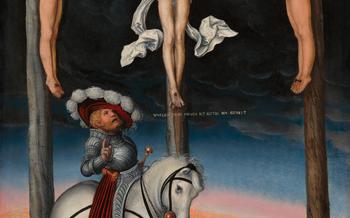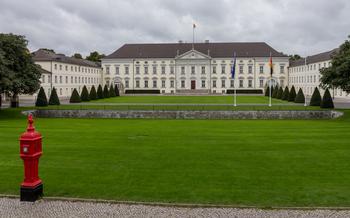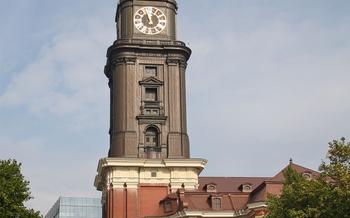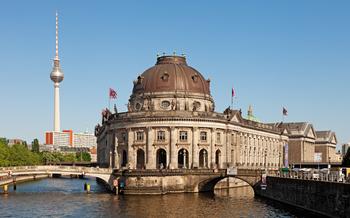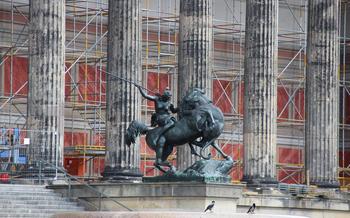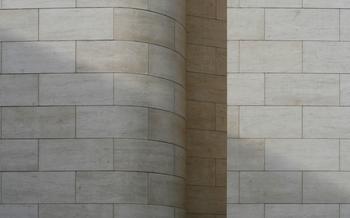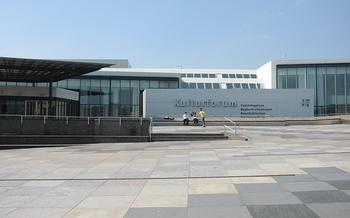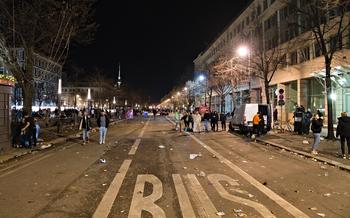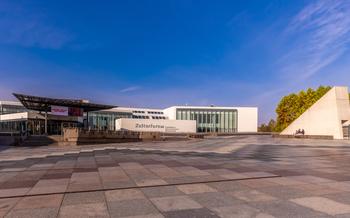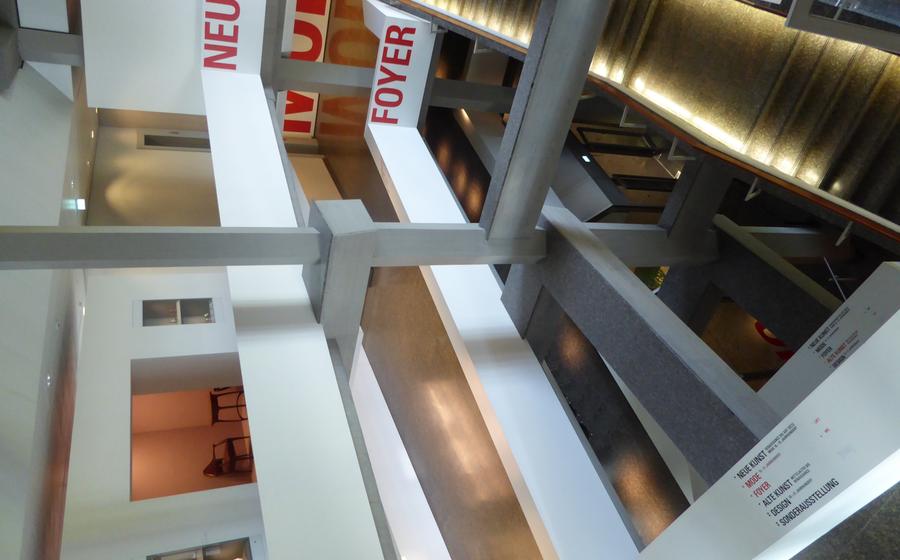
The Museum of Decorative Arts
- Historical Background
- Location and Accessibility:
- Special Exhibitions
- Educational Programs
- Architecture and Design:
- Museum Shop
- Accessibility Features
- Visitor Information
- Museum Cafe
- Photography and Social Media
- Nearby Attractions
- Seasonal Events
- Sustainability Initiatives
- Insider Tip:
Historical Background
The Kunstgewerbemuseum, or Museum of Decorative Arts, in Berlin, Germany, holds an exceptional legacy as a prominent institution dedicated to the preservation and celebration of decorative arts. Founded in 1867, the museum initially focused on promoting German craftsmanship and design, reflecting the country's burgeoning industrial prowess during that era. Over the years, it has evolved into a world-renowned hub for decorative arts, amassing a remarkable collection that spans various historical periods and cultures.
The museum's establishment was driven by a desire to showcase the finest examples of applied arts, fostering an appreciation for craftsmanship and design excellence. It quickly became a platform for showcasing the works of renowned German artists and designers, contributing to the recognition and development of German design aesthetics. The museum's influence extended beyond national borders, inspiring and influencing international design movements throughout the 20th century.
Today, the Kunstgewerbemuseum stands as a testament to the enduring significance of decorative arts, offering visitors a captivating journey through the history of design and craftsmanship. Its diverse collection and innovative exhibitions continue to captivate art enthusiasts, design professionals, and curious minds alike, cementing its reputation as a must-visit destination for anyone interested in the world of decorative arts.
Location and Accessibility:
The Kunstgewerbemuseum is conveniently located in the heart of Berlin, at the Kulturforum, Potsdamer Straße 50. Its central position makes it easily accessible by various means of transportation. Visitors can take advantage of the excellent public transport network, with bus stops and underground stations nearby. For those arriving by car, there are several parking facilities in the vicinity. The museum's proximity to other cultural attractions, such as the Gemäldegalerie, the Neue Nationalgalerie, and the Philharmonie, allows visitors to create a full day of cultural exploration.
Special Exhibitions
The Kunstgewerbemuseum continuously presents a diverse array of special exhibitions, each delving into specific themes or showcasing the works of renowned artists and designers. These exhibitions are a highlight for visitors seeking an in-depth exploration of various facets of decorative arts.
Past special exhibitions have captivated audiences with their unique perspectives and innovative presentations. For instance, the "Design Dialogues" exhibition explored the connections between historical and contemporary design through juxtaposing works from different eras. The "Masters of Glass: Émile Gallé and René Lalique" exhibition showcased the exquisite creations of these two glass masters, highlighting their groundbreaking techniques and artistic vision.
To stay informed about current and upcoming special exhibitions, visitors are encouraged to check the museum's website regularly. These exhibitions offer a dynamic and ever-changing experience, allowing visitors to discover new perspectives on decorative arts and contemporary design.
Educational Programs
The Kunstgewerbemuseum is dedicated to promoting art education and providing visitors with opportunities to learn more about decorative arts. The museum offers a wide range of educational programs, including guided tours, workshops, and lectures. Guided tours are available in various languages and provide visitors with an in-depth look at the museum's collection and its history. Workshops are offered on a variety of topics related to decorative arts, such as ceramics, furniture making, and textile design. Visitors can learn from experienced artists and craftspeople and create their own decorative art pieces. The museum also hosts regular lectures and talks by experts in the field of decorative arts. These events provide visitors with opportunities to learn about the latest trends and developments in the field.
In addition to its on-site programs, the Kunstgewerbemuseum also offers a variety of educational resources online. The museum's website features a wealth of information on the history of decorative arts, the museum's collection, and its educational programs. Visitors can also access online exhibitions, videos, and interactive activities. The museum's social media channels provide up-to-date information on upcoming events and exhibitions, as well as behind-the-scenes glimpses into the museum's work.
Architecture and Design:
The Kunstgewerbemuseum is housed in a striking red-brick building designed by the renowned architects Martin Gropius and Heino Schmieden. Completed in 1881, the building is a masterpiece of High Victorian Gothic architecture, featuring vaulted ceilings, a grand staircase, and intricate decorative details. The museum's impressive facade is adorned with sculptures and friezes that reflect the building's purpose and showcase the craftsmanship of the period.
Inside, the museum's spacious galleries are designed to enhance the visitor experience. The vaulted ceilings create a sense of grandeur, while the natural light streaming through the large windows illuminates the exhibits and highlights their intricate details. The grand staircase, with its ornate balustrades and sweeping curves, is a focal point of the museum and invites visitors to explore the different levels and collections.
The Kunstgewerbemuseum's building is not just a container for its collection but an integral part of the museum experience. As a protected historical monument, it represents Berlin's rich architectural heritage and serves as a reminder of the importance of preserving and celebrating the past.
Museum Shop
The Kunstgewerbemuseum offers a well-curated museum shop where visitors can find a variety of items related to the museum's collection and exhibitions. From beautifully illustrated books and catalogues to postcards and posters featuring iconic pieces from the museum's holdings, there is something for every taste and budget. Visitors can also purchase high-quality reproductions of decorative arts objects, such as ceramics, glassware, and jewelry, allowing them to take a piece of the museum's collection home with them.
The museum shop also offers a selection of design-related souvenirs and gifts, such as stationery, homeware, and accessories inspired by the museum's exhibits. These items make for thoughtful presents for friends and family who share a passion for decorative arts and design. By purchasing from the museum shop, visitors not only support the museum's educational and preservation efforts but also have the opportunity to own a unique and meaningful memento of their visit.
Accessibility Features
The Kunstgewerbemuseum is committed to providing an accessible and inclusive environment for all visitors. The museum has implemented various facilities and services to ensure that visitors with disabilities can fully enjoy their visit. Wheelchair ramps and elevators are available throughout the museum, making it easy for visitors with mobility impairments to navigate the building. The museum also offers audio guides and other assistive devices for visitors with hearing or visual impairments. Additionally, the museum's website and signage are designed to be accessible to visitors with cognitive disabilities. The museum's staff is trained to assist visitors with disabilities and ensure that they have a positive and enjoyable experience.
Visitor Information
The Kunstgewerbemuseum is open to the public Tuesday through Sunday from 10 am until 6 pm. It is closed on Mondays and major holidays. Admission fees vary depending on the type of ticket and any special exhibitions that may be running at the time of your visit. Standard admission tickets are currently priced at 10 euros for adults, 5 euros for reduced admission, and free for children under 18 years of age. Visitors can purchase tickets online or at the museum's ticket counter. Guided tours in English and German are available for an additional fee and can be booked in advance or upon arrival. The museum also offers a variety of discounts and special offers, such as reduced admission for students and seniors, as well as family tickets. For the most up-to-date information on hours, admission fees, and discounts, please visit the museum's website or contact the museum directly.
Museum Cafe
The Kunstgewerbemuseum offers a delightful museum cafe where visitors can take a break from their cultural exploration and indulge in a culinary experience. Located in a serene corner of the museum, the cafe exudes a cozy and inviting atmosphere with its warm lighting, comfortable seating, and tasteful decor.
The menu features a delectable array of refreshments, including freshly brewed coffee, fragrant teas, and a selection of pastries and cakes that are sure to tantalize your taste buds. For those seeking a more substantial meal, the cafe offers a range of light bites, such as sandwiches, salads, and soups, allowing you to refuel while still immersing yourself in the museum's treasures.
Whether you're seeking a quick caffeine fix or a leisurely lunch break, the museum cafe provides the perfect oasis to relax and recharge. It's an ideal spot to reflect on the intricate artistry you've encountered in the galleries or simply to engage in lively conversations about your favorite exhibits. As you savor your refreshments, you can continue to be inspired by the museum's surroundings, with glimpses of exquisite decorative arts pieces enhancing your dining experience.
So, when you visit the Kunstgewerbemuseum, be sure to allocate some time to unwind and indulge in the culinary delights of the museum cafe. It's the perfect way to complete your journey through the world of decorative arts, leaving you refreshed and inspired to continue your explorations.
Photography and Social Media
The Kunstgewerbemuseum encourages visitors to share their experiences and photos on social media, creating a vibrant online community of art enthusiasts. Visitors are welcome to take photos and videos for personal use, but flash photography and tripods are prohibited to ensure the preservation of the artworks. The museum also asks visitors to be respectful of other visitors and the museum staff when taking photos or videos. By using the museum's hashtags (#kunstgewerbemuseum, #designmuseumberlin), visitors can connect with others who share their passion for decorative arts and contribute to the museum's digital presence.
Nearby Attractions
The Kunstgewerbemuseum's central location in Berlin places it within easy reach of numerous other cultural attractions and landmarks. This proximity presents an opportunity for visitors to create a comprehensive cultural itinerary, exploring multiple destinations in a single day.
A short walk from the museum, visitors can find the Kulturforum, a cultural complex housing several world-renowned museums, including the Gemäldegalerie (Picture Gallery), the Neue Nationalgalerie (New National Gallery), and the Kupferstichkabinett (Museum of Prints and Drawings). These institutions offer a diverse range of art collections, from Old Masters to modern and contemporary works.
Just across the street from the Kunstgewerbemuseum lies the Staatsoper Unter den Linden (State Opera House), a grand opera house known for its impressive architecture and acoustics. Visitors can attend a performance or take a guided tour to admire the opulent interiors and learn about the opera's rich history.
For those interested in exploring Berlin's vibrant art scene, the Auguststraße district, located a short walk from the museum, is home to numerous galleries and art spaces. Here, visitors can discover emerging and established contemporary artists and browse a variety of exhibitions.
To enhance their visit, visitors can take advantage of the Museum Pass Berlin, which grants free admission to over 30 museums on the Museum Island and throughout the city, including the Kunstgewerbemuseum. This pass offers a cost-effective way to explore Berlin's rich cultural landscape.
Seasonal Events
Throughout the year, the Kunstgewerbemuseum hosts a variety of seasonal events and activities that enhance the visitor experience. These events offer unique opportunities to engage with the museum's collection and explore different aspects of decorative arts.
During the holiday season, the museum transforms into a festive wonderland, with special exhibitions, workshops, and performances that celebrate the spirit of the season. Visitors can enjoy festive decorations, themed guided tours, and hands-on activities that bring the museum's collection to life.
In the spring and summer months, the museum often hosts outdoor events and workshops in its beautiful courtyard. These events provide a chance to appreciate the museum's architecture and enjoy the warm weather while engaging with the collection. Visitors can participate in outdoor sketching sessions, guided tours focusing on the museum's gardens, or workshops on traditional crafts and techniques.
Keep an eye on the museum's website or social media pages for updates on upcoming seasonal events and activities. These events are a great way to experience the Kunstgewerbemuseum in a new and exciting way, so be sure to check them out during your visit.
Sustainability Initiatives
The Kunstgewerbemuseum is dedicated to sustainability and environmental responsibility, actively working to reduce its ecological footprint. The museum has implemented various initiatives to achieve this goal. For instance, the museum uses energy-efficient lighting and climate control systems to minimize energy consumption. Additionally, it promotes recycling and waste reduction throughout its operations. Visitors can contribute to these efforts by making eco-conscious choices during their visit, such as using reusable water bottles and recycling materials in designated bins. By embracing sustainability, the Kunstgewerbemuseum demonstrates its commitment to preserving both cultural heritage and the environment for future generations.
Insider Tip:
To truly appreciate the splendor of the Kunstgewerbemuseum, plan your visit for a weekday morning. This is when the crowds are typically smaller, allowing you to immerse yourself in the exhibits without feeling rushed. Take your time to explore the diverse collection, and don't miss the Waddesdon Bequest, a dazzling display of medieval and Renaissance decorative arts. The intricate craftsmanship and historical significance of these pieces are simply breathtaking. Remember to check the museum's website before your visit to confirm any special events or closures.
